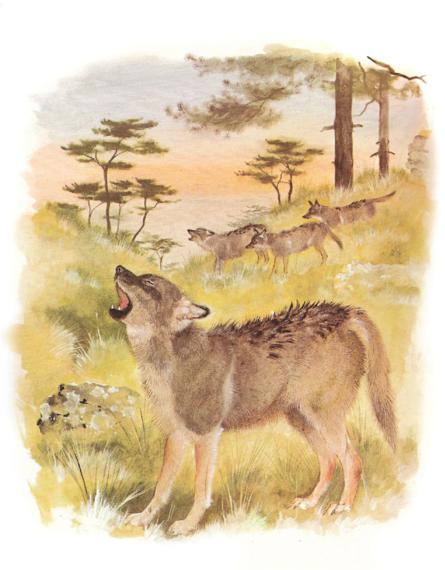
FIRST WATCH 3 P. M. NONE
SHAMANU OR JAPANESE WOLF – 1904
Canis lupus hodophilax
Hirata Atsutane – 1810
The Superiority of the Ancients
, Japan
There are many wolves which are called the messengers of the gods of the mountains, and people from other parts of the country come and, applying through the guards of these mountains, choose and borrow one of these wolves as a defence against fire. That is to say they only arrange to borrow it and do not take a wolf to their place. And from the day of borrowing they offer daily food to the spirit of the wolf.
The Shinto shrine Mitsumine Jinga was an important site of wolf worship in Japan. By tradition it was built by Prince Yamato Takeru, the legendary unifier of Japan in the 4th century, who, during his campaign of pacification of central Honshu, became lost in the mountain passes of the Karisaka. He was rescued and guided out of the mountains by a supernatural white wolf.
The Shamanu or Yamainu (meaning “Mountain Dog”) was the world’s smallest wolf: weighing about 14 lbs, it measured from 12-16 inches at the shoulder, and just a little over 3 1/2 feet in length (including its one-foot-long tail). The Shamanu was endemic to the Japanese islands of Honshu, Shikoku and Kyushu.
By the Ainus, the aboriginal Japanese people, the Shamanu was called the “Howling God” because it so often howled for hours from hilltops and mountains. There is an Ainu myth origin about a white wolf that mates with a goddess; the offspring of this union became the ancestors of the Ainu.
Coenraad Jacob Temminck – 1839
Fauna Japonica,
Leiden, Holland
The Shamanu or Japanese Wolf is chiefly distinguished from the European Wolf by its smaller size and shorter legs. It is as much dreaded by the Japanese as the European Wolf is in its range.
The Shamanu or Honshu Miniature Wolf was first described to Western science in 1839 as Canis hodophilax by Coenraad Temminck, the first director of the Dutch Museum of Natural History. This was based on specimens from the first zoological expedition to Japan by Philipp Franz von Siebold and Heinrich Burger, both Germans, employed by the Dutch at a trading post near Nagasaki.
The Shamanu was just one of several hundreds of species classified by Coenraad Temminck, twenty of which carry his name. Although there is some dispute over the matter, today the Shamanu is commonly classified as a subspecies of the Grey Wolf: Canis lupus hodophilax.
C. P. Hodgson – 1860
A Residence in Nagasaki and Hakodate
, Japan
Wolves were brought to the doors of the omnivorous Europeans and offered for sale. Every Japanese house in the north had, as well as a notice giving street number and family details, a charm to keep wolves away from their doors.
Small as it was, the Shamanu seems to have been greatly feared by the Japanese. However, there was once one other indigenous wolf on the island of Hokkaido. This was the Ezo Wolf (Canis lupis hattai), which became extinct in Japan by 1888. It was a much larger animal than the Shamanu: heavier and longer, with a bigger head and more powerful teeth and jaws. Already rare by the mid-19th century, bounties of 7 to 10 yen ensured its extinction. Between 1878 and 1888, more than 1,500 Ezo Wolves were brought in for bounty. Since then, no sign of this animal was seen again in Japan.
N. P. Anderson – 1905
Anderson’s Report – British Zoological Expedition
, Japan
This Wolf was purchased in the flesh, and I can learn but little about it. It is rare, some say almost extinct.
N. P. Anderson was a collector for a British expedition to Japan. This skin and skull are now to be found in the British Natural History Museum in South Kensington, London. It is one of the only two or three specimens in existence outside Japan. There is a fully mounted specimen from the Fukushima Prefecture, Hondo which is preserved in the Tokyo Science Museum.
Anderson was correct about it being rare, but incorrect about it being “almost extinct.” The animal killed for the British collectors on 23 January 1905, near the village of Washikaguchi, Nara Prefecture, Honshu, was the very last the world would ever see of the Shamanu: the little Howling God that was the Japanese Wolf.
THE HOWLING GOD
Shamanu or Japanese Wolf – 1905
Broken wolf’s tooth
A charm, set in pounded gold
Ancient blood in a bronze bowl
Shogun hunted Shamanu, the little wolf,
Through forests and stony fields
Horses and dogs chased him to mountains
Beneath exhausted stars
In ancient days
Legends gave him hypnotic power
Geese swooned before
The glowing of his eyes
Beneath the willow tree
Travellers and pale maidens
Succumbed to his voice
Shamanu, the little Howling God,
Ascends the Nine Heavens
Wanders the land of nine jade rivers
And nine jade mountains
Shamanu’s blood is red amber now
His eye is sapphire
His flesh the cinnabar ore
That gives up bright quicksilver
And deadly vapour